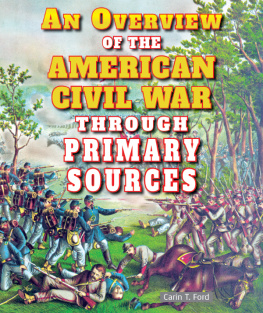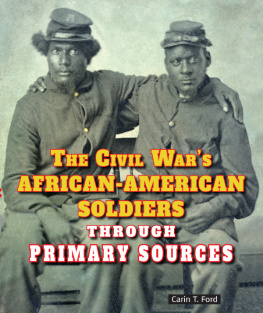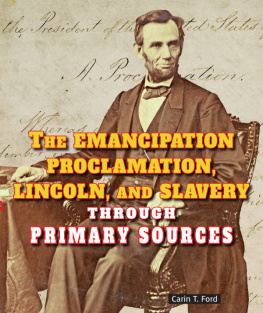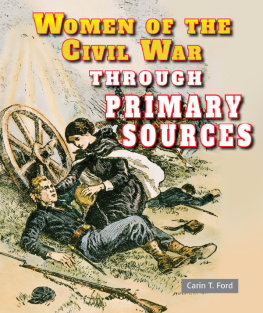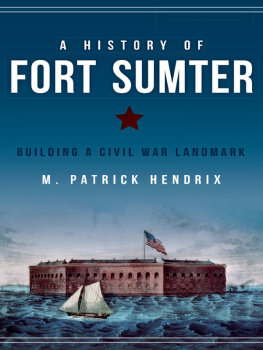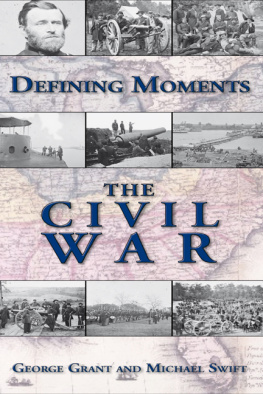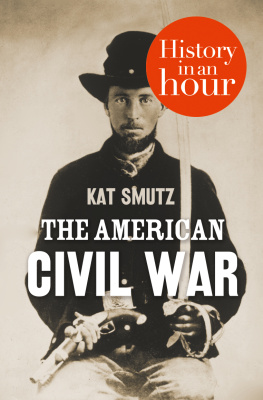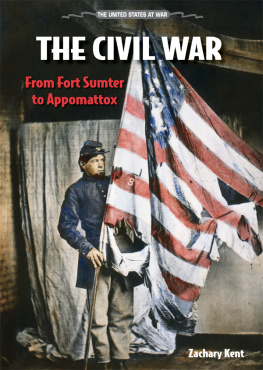A House Divided Against Itself Cannot Stand
In April 1861, Abraham Lincolns prophetic words came true when Confederate soldiers attacked Fort Sumter, beginning the Civil War. The war pitted North against South, brother against brother, neighbor against neighbor. The issue of slavery had torn the nation apart. War would be required to put it back together. Author Carin T. Ford uses primary sources to tell the story of the war that reunited the Union and ended slavery forever.
About the Author
Carin T. Ford has been writing professionally for more than twenty-five years, including many books for Enslow Publishers, Inc. In addition to writing, she teaches English and journalism at colleges in the Philadelphia area.

Image Credit: Library of Congress Prints and Photographs
In this 1862 photograph, African-American slaves plant sweet potatoes at Hopkinsons Plantation in South Carolina. The issue of slavery stirred up a conflict in the United States in the mid-1800s.
The people of the United States faced a big question in the 1800s: What should be done about slavery?
The businesses, factories, and small farms of the North did not depend on slave labor. As time passed, most people in the Northern states had come to believe that slavery was wrong. One by one, these states had been putting an end to slavery.
On the large farms of the South, however, 4 million slaves were forced to work in the fields, growing cotton, rice, and tobacco. Slaves worked from sunrise to sunset. They were bought and sold like animals. They were given little food or clothing, and their masters often beat them.
Some Southerners believed slavery was wrongyet they still thought it was needed. The South grew most of the cotton sold in the world. Without slaves, who would work in the fields? Southerners were afraid they would lose a lot of money, as well as their way of life, if they did not have slaves to grow their cotton.
In addition, people in the South did not think the federal government had the right to tell them whether they couldor could nothave slaves. They believed it was up to the people of each state to decide for themselves.
Meanwhile, the United States was growing. New states and territories were becoming part of the country. Should slavery be allowed in these areas?
Questions about slavery were nothing new. As early as 1787, Thomas Jefferson, James Madison, and other important American leaders had talked about these problems when they were writing the U.S. Constitution. They were not sure whether they should write laws that would do away with slavery.

Image Credit: Library of Congress Prints and Photographs
Slaves were often treated cruelly and punished harshly. This 1807 woodcut shows an iron mask, collar, leg shackles, and spurs used to restrict slaves. Northerners wanted to get rid of slavery, but Southerners said it was necessary for their economy to survive.
They finally decided it was not worth arguing about. They wanted to make sure that all the states joined the newly formed United States of America. If the Constitution outlawed slavery, Southerners might not want to be part of the new nation.
Besides, in the 1780s, it had seemed as if slavery was on its way out. Many Northern states had already taken steps to get rid of it. In the South, farmers grew less tobacco, so fewer slaves were needed.
Then, in 1793, Eli Whitney invented the cotton gin. With this new machine to pick out the seeds, cleaning cotton was faster and more efficient. As long as plantation owners had hundreds of men and women to work in the fields, they could grow and sell tons of cotton.
The issue of slavery was tied up with the issue of states rights. Many Southerners did not like the federal government telling them what to do. In 1832, South Carolina had talked about breaking away from the country when the government passed a tax law the state did not want to obey.

Image Credit: Congress Prints and Photographs
President Abraham Lincoln often spoke out against slavery.
There was fighting over slavery even before the Civil War broke out. When Kansas was made a territory in 1854, the people there had to decide whether it would be a slave state or a free state. Fighting between the two sides was so horribleand went on so longthe area was called Bleeding Kansas. It entered the Union as a free state in January 1861.
The problem of slavery never went away. In fact, it got worse through the years. By the mid-1800s, it looked as if the country might split in half over slavery.
Abraham Lincoln was elected president in 1860. He often spoke out against slavery. If slavery is not wrong, nothing is wrong, he said. Yet Lincoln also knew that there was a great deal of tension between the North and South. He worried that if he tried to get rid of slavery, Southerners might secede, or break away, from the United States and form their own country. Lincoln did not want the United States torn in half. So he did not talk about ending slavery. Instead, he argued that slavery should not be allowed to spread into new areas.

Image Credit: Enslow Publishers, Inc.
In December 1860, South Carolina seceded from the Union. Soon, other Southern states left, too. This map shows the United States divided between Union and Confederacy during the Civil War.
Still, the people in the South worried that Lincoln would try to put an end to slavery everywhere. In December 1860, South Carolina seceded from the United States. Alabama, Florida, Mississippi, Louisiana, Texas, and Georgia soon followed.
They formed their own country, the Confederate States of America, and Jefferson Davis was elected their president. We feel that our cause is just and holy, he said.
Most Southerners reacted joyfully to the news. We have a country at last, to live for, to pray for, and, if need be, to die for! said Lucius Quintus Lamar, a former Mississippi congressman.
Yet not everyone thought the decision to secede was wise. You people of the South dont know what you are doing, said William Tecumseh Sherman. This country will be drenched in blood. You are rushing into war [and] are bound to fail.
Sherman went on to become a famous general for the North during the Civil Warand his words came true. During the next four years, more than 600,000 men would give their lives in the bloodiest war ever fought on American soil.

Image Credit: Library of Congress Prints and Photographs
This photo shows the interior of Fort Sumter with the Confederate flag flying after the Souths victory over the Union. This battle marked the first combat of the Civil War.
The new Confederate government soon began taking over all the U.S. forts and arsenalswhere weapons are storedin the South. President Lincoln did not want war. More than anything else, he wanted to put the country back together peacefully. There will be no blood shed unless it be forced upon the Government, Lincoln said in February 1861.

